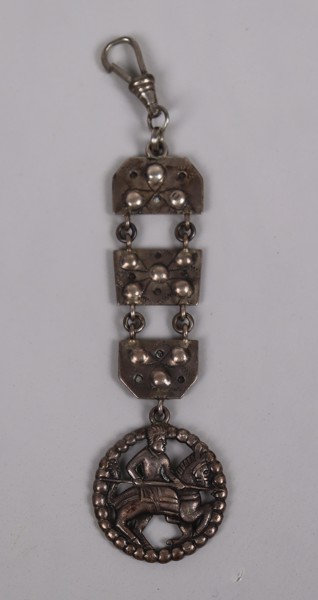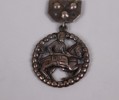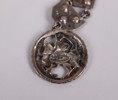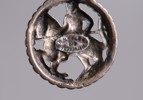41963 Henrik Møller, Trondheim, Norway, klockkedja i silver med medeltida dekor

Stämplat 830 silver.
Längd 13,5cm.
| Köparprovision (inkl. moms) | 20% |
| Slagavgift (inkl. moms) | 30 SEK |
Henrik Møller (1858-1937)
I kategori Art
Henrik Bertram Møller (11 October 1858 – 16 May 1937) was born in the Norwegian town of Trondheim, the son of goldsmith Jacob Andreas Møller (1822 – 1870), and the fourth generation of a family of jewelers who moved to Trondheim in 1770. Møller’s mother, Marie Christine Moe (1837 – 1918) managed the family’s workshop following his father’s death in 1870, and it was here that he began his apprenticeship at the age of 14. After traveling and studying in Copenhagen, Vienna, and New York, Møller return to Trondheim in 1884, where he married Marie Gunhilde Aas (1864 – 1947) on 14 May 1890. Though Møller did create works for the domestic market, such as tea services and jewelry, as well as utilitarian works such as door handles and ship lamps through his company Henrik Møllers Metalvarefabrik which opened in 1900, his largest output was silver works in the dramatic Dragestil or “Dragon Style” for royalty, industrialists, and wealthy tourists prior to World War I, including Andrew Carnegie, Queen Wilhelmina of the Netherlands and King Chulalongkorn of Siam, now Thailand.
The Dragestil movement emerged in Norway as part of a broader shift towards Romantic Nationalism in the second half of the 19th century across arts, architecture, and even language. Beginning in 1814, Sweden and Norway were in a single union, which led to efforts to distinguish Norwegian culture as unique from their neighbor. Dragestil originally emerged in the field of architecture, evolving from a Swedish form of traditional architecture popular in the 1870’s, and influenced by new research into the ornamentation of wooden stave churches and Medieval Norse architecture published in the 1890s. In the decorative arts, this style manifested in the use of dragons and other fantastical creatures, as well as the dense vines and strap work inspired by Norse mythology and Sagas, found on these historic structures. An example can be seen in the decoration of the doors of the Hylestad Stave Church, which was built in the late 12th/early 13th Century and demolished in the 17th century. The doors, which were preserved, depict scenes from the Legend of Sigurd Fåvnesbane through flattened stylized figures surrounded by coiling vines and dragons.
Works by Henrik Møller can be found in important Norwegian collections, including the Nasjonalmuseet in Oslo, and the Nordenfjeldske Kunstindustrimuseum in Trondheim. The Nasjonalmuseet is home to a bowl on stand with similar writhing dragons and supported by comparable gargoyles as those found on the present lot (Inv. No. NMK.2013.0345). At auction, a similarly decorated drinking horn resting on the back of a dragon was sold at Christie's, London, 21-22 August 2019, lot 108. Further, a large cup and cover decorated with scenes from Norse mythology was sold at Skinner Auctions, Boston, 31 March 2012, lot 116, and a tobacco box was sold at Bonhams, London, 17 April 2013, lot 164.

Öppettider
Måndag: 12:00 - 18:00
Torsdag: 12:00 - 20:00
Lördag: 09:00 - 14:00
Övriga dagar efter överenskommelse
Torsdag 15/8 16:00 - 20:00
© Software Copyright 2024 Skeleton. All rights reserved.






